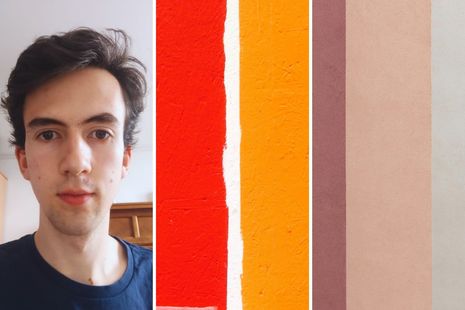I tried colour analysis and it was much harder than it looks
Alex Brian surrenders all his data to discover whether he’s ‘dark autumn’ or ‘true winter’

You must have seen the TikToks: different coloured fabrics are draped over someone in a chair while a colour analysis professional harshly rejects their opinions. No, they don’t look good in “true winter” colours. Can’t you see? They’re clearly “dark autumn”. Swamping my explore page, these videos always leave me feeling righteously arrogant. Despite never having studied colour analysis, I convince myself I know better than the seasoned professional behind the chair. I needed a reality check so I decided to have a proper go.
“This seemed like another iteration of humanity’s obsession with categorising ourselves”
Admittedly, I went in feeling dubious about the whole thing. Colour analysis is expensive (anything between £150-£650), wasteful (what do you do if they say your wardrobe is wrong? Bin everything?) and long ignored the existence of anyone but white women. Devised in the 1980s, the technique now comprises multiple approaches, the most common of which divides people into four seasons, each with three sub-seasons, based on their complexion. Each sub-season (e.g., soft summer) contains a range of colours designed to make the wearer look energised. To me, this seemed like another iteration of humanity’s obsession with categorising ourselves, whether through astrology or BuzzFeed quizzes.
Nevertheless, I dived straight in the way anyone would: googling “colour analysis” and choosing the first result (colorenalysis.com). After selecting my hair, eye and skin colours from a highly restrictive list, I entered my email (goodbye uncluttered inbox) to discover that I’m “clear”, whatever that means, and should wear black with pops of neon green, red and purple. Alongside these bold choices was the suggestion I don bright gems and white pearls. By the time I was being advised to wear animal prints based on my complexion, I had lost all faith in colorenalysis.com.
“The advantages of colour analysis when curating individual aesthetics are clear”
The next website I tried, colorwise.me, had slightly more advanced technology. Having uploaded a selfie, I used a dropper to select my hair, skin and eye colours. The “deep winter” hues that emerged were much closer to my usual blues and purples. I then had the option of personalising my colour palette. So far, so good.
Using their app was a much more disorienting experience. Staring into my phone for several minutes, I was flashed with a dizzying array of colours, eventually resulting in a series of photos of me surrounded by different colour palettes. Unfortunately, as well as making me light-headed, the flashing rendered me extremely pale in every photo, leaving me none the wiser as to my season.
*Sigh* I would have to try the old-fashioned way. I started draping clothes over myself but, as they were from my own wardrobe, I inevitably liked most of them. I attempted to determine my undertone (whether my skin is more blue or yellow) but soon felt queasy from staring at my face too long. I initiated a colour theory deep dive, ending up on the GCSE Art side of YouTube. While certainly learning more about shades, tints and tones than I ever did at school, I was no closer to understanding whether my complexion was clear or muted, warm or cool.
“Every website I accessed tried to sell me some ridiculously expensive service”
Here was my reality check. Colour analysis is, in fact, incredibly complex, with some even proposing 16 categories or considering personality. The technique generates enough discourse to fill an entire subreddit. Why did I ever think I had a shot?
While you still won’t find me paying £200 for someone to criticise my wardrobe, this adventure has made me think more about colour when purchasing clothes. It’s undeniable that our complexions influence how we look in different colours and, although their divisions are somewhat arbitrary and far from universally applicable, colour analysis charts can make it easier to determine what works for you.
While the idea of us all developing personal “branding” colours concerns me, the advantages of colour analysis when curating individual aesthetics are clear. I appreciate its fusion of the artistic and scientific dimensions of fashion and its inspirations in nature. Not only might it facilitate shopping, but it could reduce waste, with people less likely to buy clothes that don’t suit them.
Nevertheless, every website I accessed tried to sell me some ridiculously expensive service. While my morning of research proved insufficient for deciphering the world of colour analysis (I’m potentially dark winter??), it’s not impossible for laypeople to grasp the system. It will take time and effort but, hey, you have the whole summer ahead of you. Why not save money and do it yourself?
Capitalism loves categorising people, whether that’s into arbitrary “generations” or increasingly niche Spotify genres. Indeed, the more specific the category, the easier it is to target advertisements. Colour analysis might be the same. Yet there is some truth to it; colours can make or break an outfit. Don’t go ditching your entire wardrobe because you’re “light spring” – but do have some fun with it.
After all, who doesn’t love a BuzzFeed quiz?
 News / Caius mourns its tree-mendous loss23 December 2025
News / Caius mourns its tree-mendous loss23 December 2025 News / Clare Hall spent over £500k opposing busway 24 December 2025
News / Clare Hall spent over £500k opposing busway 24 December 2025 Comment / Yes, I’m brown – but I have more important things to say22 December 2025
Comment / Yes, I’m brown – but I have more important things to say22 December 2025 Comment / The ‘class’ of Cambridge24 December 2025
Comment / The ‘class’ of Cambridge24 December 2025 Interviews / Politics, your own way: Tilly Middlehurst on speaking out21 December 2025
Interviews / Politics, your own way: Tilly Middlehurst on speaking out21 December 2025








